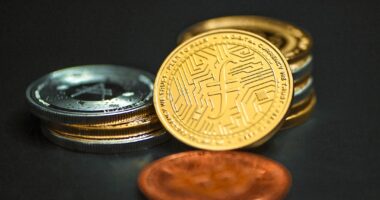Non-fungible tokens (NFTs) are digital assets representing ownership or authenticity of unique items or content, such as artwork, videos, music, or collectibles, using blockchain technology. Unlike fungible cryptocurrencies, NFTs are unique and cannot be exchanged on a one-to-one basis. This uniqueness gives NFTs their value and appeal to collectors and investors.
NFTs utilize blockchain technology to create digital certificates of ownership stored on a decentralized ledger. These certificates contain information about the item, including its creator, current owner, and a unique identifier. The information is immutable, transparent, and publicly verifiable.
When an NFT is traded, ownership information is updated on the blockchain, ensuring secure and transparent transfers. This process allows creators and owners to monetize and authenticate digital content. The rise of NFTs has significantly impacted the art world, revolutionizing the buying, selling, and collecting of digital art.
NFTs provide digital artists with a new way to monetize their work and reach a global audience. By tokenizing art as NFTs, artists create scarcity and provenance for digital creations, increasing their value and desirability. This has created new opportunities for artists to earn a living from digital art, which was previously challenging in traditional art markets.
NFTs have also transformed art collection and experience by enabling ownership and display of digital art in a decentralized and secure manner. Collectors can confidently trade digital art, knowing they have proof of ownership and authenticity through blockchain-stored NFTs. This has led to increased interest and investment in digital art, with some NFT artworks selling for millions of dollars at online auctions and marketplaces.
The accessibility and inclusivity of the NFT art market have attracted new audiences to the art world, as anyone with internet access can participate in buying and collecting NFT art.
Key Takeaways
- NFTs are unique digital assets that are stored on a blockchain and cannot be replicated or replaced.
- The rise of NFTs has revolutionized the art world, allowing artists to sell their work directly to collectors and bypass traditional gatekeepers.
- There is potential for exploitation in the NFT market, including issues with copyright infringement and environmental concerns related to energy consumption.
- Comparing NFTs to pyramid schemes highlights the speculative nature of the market and the potential for investors to lose money.
- Ethical considerations surrounding NFTs include questions about ownership, authenticity, and the impact on the environment.
- Navigating the NFT market responsibly involves conducting thorough research, understanding the risks, and supporting artists and creators.
- The future of NFTs is uncertain, but they are likely to play a significant role in the art and digital asset industries, potentially changing the way we buy, sell, and collect art and other digital assets.
The potential for exploitation in the NFT market
Fraud and Copyright Infringement Concerns
While NFTs have brought about exciting opportunities for artists and collectors, there is also potential for exploitation in the NFT market. The decentralized and pseudonymous nature of blockchain technology can make it difficult to verify the authenticity and provenance of NFTs, leading to concerns about fraud and copyright infringement. Some artists have reported instances of their work being tokenized and sold as NFTs without their permission, raising questions about the ethical implications of NFT ownership and the rights of creators.
Market Volatility and Price Manipulation
Additionally, the speculative nature of the NFT market has led to concerns about price manipulation and market volatility. Some critics argue that the high prices paid for NFTs are driven by hype and speculation rather than intrinsic value, leading to a potential bubble that could burst and leave investors with significant losses.
Lack of Regulation and Oversight
The lack of regulation and oversight in the NFT market has also raised concerns about money laundering and other illicit activities taking place through the buying and selling of NFTs.
Comparing NFTs to pyramid schemes

Some critics have drawn parallels between NFTs and pyramid schemes, arguing that both rely on the continuous recruitment of new participants to sustain their value. In a pyramid scheme, participants make money by recruiting others to join the scheme, rather than from any underlying investment or product. Similarly, in the NFT market, early adopters and influencers can profit from promoting and selling NFTs to their followers, creating a sense of FOMO (fear of missing out) that drives demand and prices higher.
However, it’s important to note that there are key differences between NFTs and pyramid schemes. NFTs are based on blockchain technology, which provides transparency and security for ownership and provenance of digital assets. Additionally, NFTs can represent genuine works of art or collectibles with intrinsic value, whereas pyramid schemes rely on false promises and deception to lure participants into investing money with little chance of return.
The ethical considerations surrounding NFTs
The rapid growth of the NFT market has raised ethical considerations about its environmental impact, particularly in relation to the energy consumption of blockchain networks used to create and trade NFTs. The process of minting NFTs requires significant computational power, which consumes large amounts of electricity and contributes to carbon emissions. This has led to criticism from environmental activists who argue that the energy-intensive nature of NFTs is unsustainable and contradicts efforts to combat climate change.
Another ethical concern surrounding NFTs is the issue of cultural appropriation and exploitation. Some NFT projects have faced backlash for appropriating cultural symbols or imagery without permission or proper attribution, leading to accusations of cultural insensitivity and disrespect. Additionally, the lack of diversity and representation in the NFT space has been criticized, with calls for greater inclusivity and support for underrepresented artists and communities.
How to navigate the NFT market responsibly
For artists, collectors, and investors looking to navigate the NFT market responsibly, there are several key considerations to keep in mind. Firstly, it’s important to conduct thorough due diligence when buying or selling NFTs, including verifying the authenticity and provenance of the digital assets being traded. This may involve researching the background of the artist or creator, as well as seeking independent verification of the NFT’s ownership and rights.
Secondly, it’s essential to consider the environmental impact of participating in the NFT market and seek out platforms and projects that prioritize sustainability and energy efficiency. Some blockchain networks are exploring ways to reduce their carbon footprint through initiatives such as carbon offsetting or transitioning to more eco-friendly consensus mechanisms. Finally, it’s crucial to support ethical practices and diversity in the NFT space by championing artists from diverse backgrounds and advocating for fair compensation and recognition for their work.
This may involve participating in initiatives that promote inclusivity and representation in the NFT community, as well as supporting platforms that prioritize ethical standards and responsible stewardship of digital assets.
The future of NFTs and their role in the art and digital asset industries

Advancements in Blockchain Technology
As blockchain technology continues to evolve and mature, we can expect to see advancements in areas such as scalability, interoperability, and sustainability that will make NFTs more accessible and environmentally friendly. This could open up new opportunities for artists to create and monetize digital content in innovative ways, while also providing collectors with greater confidence in the authenticity and provenance of NFTs.
New Models for Ownership and Exhibition
The integration of NFTs into traditional art markets and institutions could lead to new models for ownership, exhibition, and preservation of digital art. Museums, galleries, and cultural organizations are exploring ways to incorporate NFTs into their collections and programming, offering audiences new ways to engage with art in virtual spaces. This convergence of physical and digital art experiences has the potential to democratize access to art while also raising important questions about ownership rights and intellectual property in a digital age.
A Responsible and Sustainable Future for NFTs
In conclusion, while NFTs have brought about exciting opportunities for artists, collectors, and investors, it’s important to approach the market with caution and responsibility. By considering ethical considerations, conducting due diligence, supporting diversity, and advocating for sustainable practices, we can help shape a more inclusive and sustainable future for NFTs in the art and digital asset industries. As technology continues to evolve and society grapples with these new forms of ownership and expression, it’s crucial to engage in thoughtful dialogue and collaboration to ensure that NFTs fulfill their potential as a transformative force for creativity and innovation.
FAQs
What is an NFT?
An NFT, or non-fungible token, is a digital asset that represents ownership or proof of authenticity of a unique item or piece of content, such as artwork, music, videos, or other digital files.
Is NFT a pyramid scheme?
No, NFTs are not inherently a pyramid scheme. NFTs are a form of digital ownership and can be bought and sold like any other asset. However, there have been instances of NFT projects exhibiting characteristics of pyramid schemes, such as promising high returns to early investors based on recruiting new participants.
What are the potential risks of investing in NFTs?
Investing in NFTs carries various risks, including market volatility, lack of regulation, potential for fraud and scams, and the speculative nature of the market. Additionally, some NFT projects may be associated with unethical or exploitative practices.
How can one avoid falling victim to NFT-related scams or exploitation?
To avoid falling victim to NFT-related scams or exploitation, it is important to conduct thorough research before investing in any NFT project. This includes verifying the authenticity of the NFT, understanding the underlying value of the asset, and being cautious of projects that promise unrealistic returns or rely heavily on recruitment of new participants. Additionally, seeking advice from financial professionals and staying informed about industry developments can help mitigate risks.





